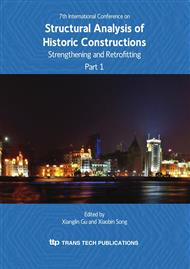p.3
p.19
p.27
p.31
p.43
p.53
p.65
p.79
Conservation of Heritage Structures in Turkey: Practice and Difficulties
Abstract:
Conservation studies in developing countries might have additional problems to those that are being experienced by leading developed countries. The problems and difficulties mentioned here do not reflect the common practice in Turkey and mostly list rare cases for information purposes. Countries located in Asia and Middle East have rich structural heritage, in number and significance, which are sometimes even a few millenniums old. On the other hand, often times financial or bureaucratic constraints make the conservation studies more difficult, while technical problems remain to be an issue. It is quite interesting that sometimes having available financial support for conservation studies turns out to be the main source of problem, since quick and not well thought interventions end up damaging hundreds of years old surviving structures, rather than conserving them. Other most common application problems include use of Portland cement in humid environments causing salt contamination (which is now widely being avoided), infilling and freezing cracks that used to work as seasonal water table movement based motion or thermal expansion joints that are cyclic in nature, covering the structure to protect but forming unintentional green house effect – micro climates forming fungus, improper drainage to cause support settlements, removing earth fill or structural members to cause structural movements and cracks, strengthening parts of a flexible structure only to make it more rigid and cause to attract more earthquake forces, disable its energy dissipating mechanisms, applying improper chemicals, using incompatible material or irreversible techniques etc. are just a few to mention. The problem solution strategies in conservation studies should include internationally accepted conservation rules. Multi disciplinary teams are always recommended since combination of various expertise areas are mutually needed in conservation studies; architects, geotechnical and structural engineers, geology and material science specialists, archeologists, art historians are among the most important team members. Analytical modeling and simulations, on-field non destructive testing, instrumented monitoring (SHM), and small scale field treatment tests are recommended to be merged and used in conservation studies, because conventional methods or commercial repair/treatment materials available over-the-counter may not always suitable for a given specific case. Reversibility, minimum intervention, and respect to authenticity should be among the main principles to avoid serious conservation problems.
Info:
Periodical:
Pages:
31-42
Citation:
Online since:
October 2010
Authors:
Keywords:
Price:
Сopyright:
© 2010 Trans Tech Publications Ltd. All Rights Reserved
Share:
Citation:


